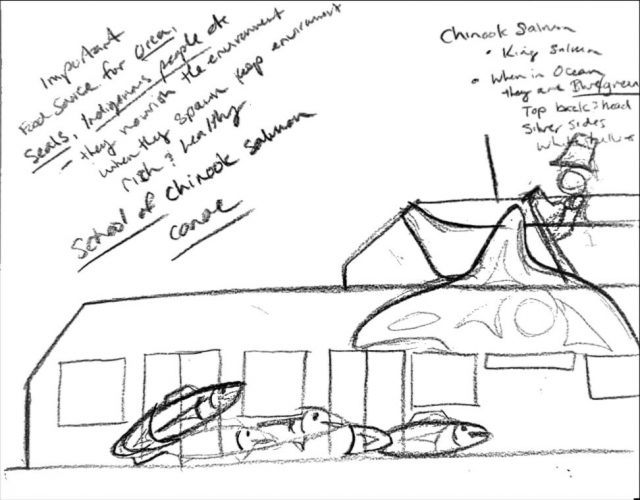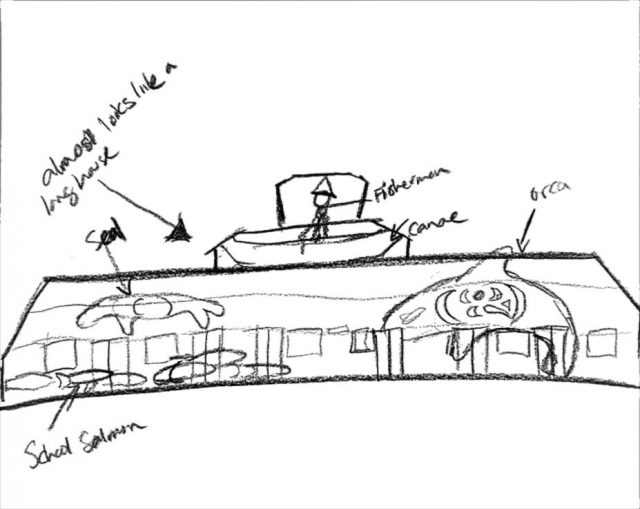Local Indigenous art commissioned for the new Burrard Chinook SeaBus
Local Indigenous art commissioned for the new Burrard Chinook SeaBus

Three Musqueam, Squamish, and Tsleil-Waututh artists have been commissioned to create an Indigenous art installation for the new Burrard Chinook SeaBus, set to enter service this summer. This is the first SeaBus to receive public art!
Musqueam, Squamish, and Tsleil-Waututh artists Kelly Cannell, Siobhan Joseph, and Angela George are working collaboratively to create artwork that will wrap the entire SeaBus.
Here at TransLink, we acknowledge, respect, and celebrate the Indigenous nations on whose territories we are fortunate to live, work, operate, and serve on. We recognize that in planning and managing the region’s transportation system we have a role to play in supporting reconciliation with Indigenous peoples. This public art initiative is one way we’re supporting reconciliation efforts.
The SeaBus operates across the Burrard Inlet, between Waterfront Station and Lonsdale Quay – the unceded traditional territories of the Musqueam, Squamish and Tsleil-Waututh.
In addition to the art, the Chinook name will also be translated into Squamish and hul’qumi’num (hən̓q̓əmin̓əm̓) – the language of the Musqueam and Tsleil-Waututh – and displayed on the vessel.

The Chinook name was selected as a tribute to the largest and most iconic of the Pacific salmon species. The Chinook salmon has played a central role in life on the west coast of British Columbia for generations. It is also a renowned swimmer and a critical part of the ecosystem in the Burrard Inlet and the northern Pacific Ocean.
Naturally, the three artists use the Chinook as a central motif of their art for the SeaBus. We’re thrilled to be able to preview with you what the artists have been working on and share what inspired their design!
Kelly Cannell
Kelly Cannell is a contemporary Coast Salish artist from the Musqueam Nation. She plans to “create flowing Chinook salmon on their journey through the Great Pacific headed for the rivers spawning grounds.”
In her proposal, Kelly explains:
The themes I have conceived for the Burrard Chinook Seabus are symbols that I hope will help bring awareness to our coastal waters, precisely the fragility of the interconnected ecosystem. I am showcasing Chinook Salmon as a link of vital importance to the Pacific Northwest waters. Once abundant but now endangered, Resident Orcas are dependent on these salmon for their survival. Chinook Salmon are also an essential food source for other wildlife throughout the Pacific Northwest Coast and are fundamental to the culture of First Nations peoples. Keeping these waters healthy and thriving is crucial for our territory.
I have included both male and female salmon on each side of the Seabus, swimming in the tidal currents. In Coast Salish culture, salmon represented in pairs signify good luck, vitality and wealth. Throughout the designs are the water’s colourful currents, and within young smolt can be found swimming. Chinook tails can be seen powering beneath the waves. My imagery is purposefully symmetrical to symbolize the sacred balance we need to sustain these waters.
She adds, “This project has been a fantastic opportunity to collaborate with talented artists of the Squamish and Tsleil-Waututh nations, our relations, and I am proud to represent Musqueam peoples.”
Siobhan Joseph
Painter Siobhan Joseph from the Squamish Nation says her vision for the art came from the shape of the SeaBus vessel with the passenger cabin almost looking like a longhouse and the bridge’s resemblance to a canoe. The bridge is where the SeaBus is operated from.
“The vision I had was a school of Chinook salmon on the lower part of the SeaBus and above the school of salmon in the upper part, I thought of killer whales and sealions,” says Siobhan. “I also thought of a canoe design because the SeaBus is like a canoe that travels across the inlet with Indigenous people in the canoe.”
The killer whales and sea lions ‘swim’ alongside the canoe and above the school of salmon to show their connection to each other.
Siobhan says the Chinook salmon are an important food source for the orcas, sealions, seals and Indigenous people. She adds the Chinook salmon also nourishes the environment when they spawn and keep the environment rich and healthy.


Angela George
Angela George carries two ancestral names, sits’sáts’tenat and qʷənat. Originally from Sḵwxwú7mesh and Sts’ailes, Angela is married to Gabriel George, and lives and works in the Tsleil-Waututh Nation (səlilwətaɬ) in North Vancouver. She highlights the life cycle of the salmon in her graphic designs. In her proposal, Angela explains:
The black arrow design that swoops around the vessel features the backbone of the salmon, returning to our lands and waters to provide nourishment and enrichment in life and in death. This reciprocal relationship ensures that all living beings and our lands and waters continue to thrive and are sustained for all time. The original people of this land had sophisticated systems and structures that governed, educated, healed and connected the people, lands, waters and all living things. The balance and harmony that was created was based on a deep understanding and relationship of inter-dependence and reciprocity. The lightening design featured around the top of the vessel demonstrates the vibrant power of lightening energy. This design represents the double-headed serpent that dwelled in the Burrard Inlet, bringing great strength and resiliency to the people. The Chinook vessel has two engines and possesses great strength like the ancient serpent from these waters. The design also represents the ripple effect of everything we do and say echoing out into the universe. This reminds us to uphold our responsibilities to our values and laws shown to us by all living things in the universe. Amidst the lightening design, there are two mountains with trails that hold the knowledge and ancient wisdom of the journeys travelled by spiritual people and hunters and gatherers, seeking the sacred medicines the mountains have to offer. These mountains and the lands and waters below offer deep healing and cleansing for all living beings to replenish and grow. The traditional knowledge, wisdom and laws of our lands and waters are held in the weavings designs and rippling out through these graphic renditions.





